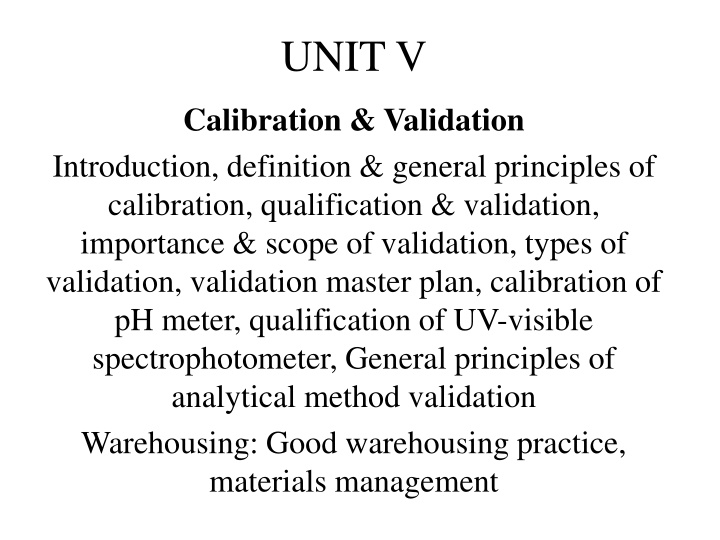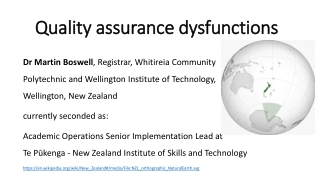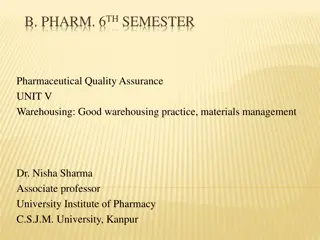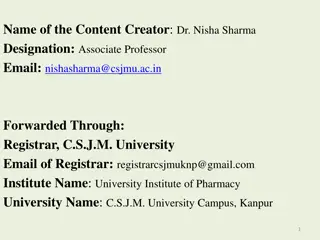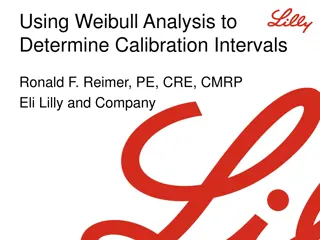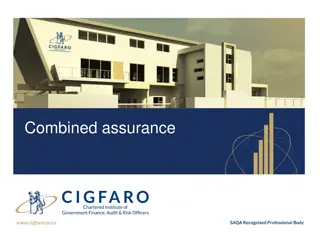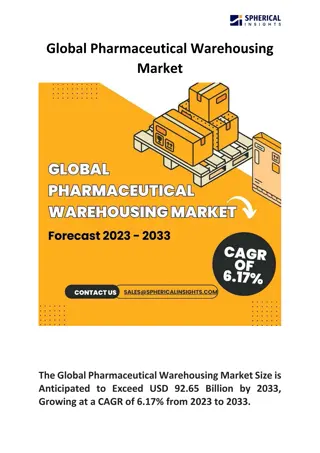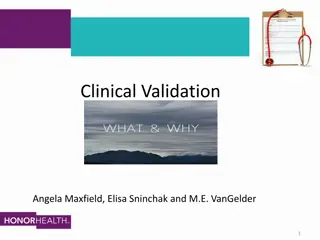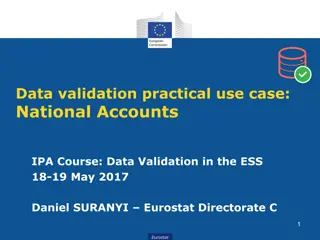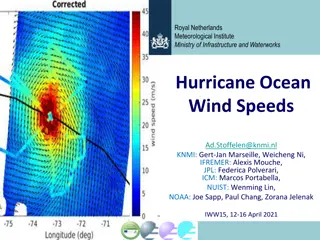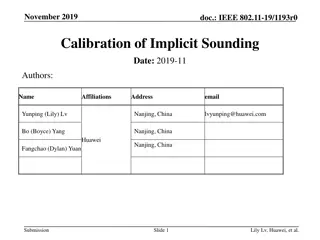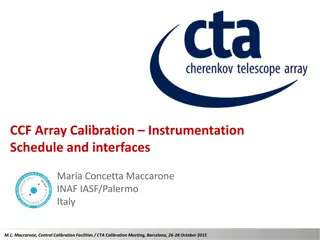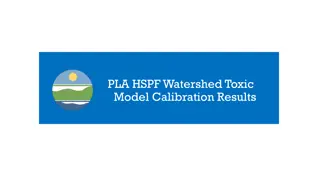Principles of Calibration, Validation, and Warehousing in Pharmaceutical Quality Assurance
Calibration and validation are critical processes in maintaining the quality of pharmaceutical products. Validation ensures that processes result in expected outcomes consistently, meeting quality standards. Qualification is an essential part of validation, ensuring that equipment and systems perform correctly. Proper warehousing practices also play a crucial role in maintaining product quality. Understanding these principles is vital for pharmaceutical quality assurance.
Download Presentation

Please find below an Image/Link to download the presentation.
The content on the website is provided AS IS for your information and personal use only. It may not be sold, licensed, or shared on other websites without obtaining consent from the author.If you encounter any issues during the download, it is possible that the publisher has removed the file from their server.
You are allowed to download the files provided on this website for personal or commercial use, subject to the condition that they are used lawfully. All files are the property of their respective owners.
The content on the website is provided AS IS for your information and personal use only. It may not be sold, licensed, or shared on other websites without obtaining consent from the author.
E N D
Presentation Transcript
UNIT V Calibration & Validation Introduction, definition & general principles of calibration, qualification & validation, importance & scope of validation, types of validation, validation master plan, calibration of pH meter, qualification of UV-visible spectrophotometer, General principles of analytical method validation Warehousing: Good warehousing practice, materials management
Calibration & Validation Introduction: Concept of Validation: Ted Byers & Bud Loftus, U.S. FDA officials, in mid 1970 s, more precise 1978 to improve the quality of pharmaceuticals Drug regulatory authorities: ask for process, procedures, intermediate stages of inspections, testing, adapted during Mfg. are adapted to produce similar, reproducible, desired results meeting quality standards .The procedures are developed through validation to maintain or assure high degree of quality. VALIDATION: essential element of Pharm. quality assurance. Validated process provides documented evidence & high degree of assurance that uniform batches meeting the required specs. will be consistently produced. Definition of validation: As per WHO: Action of proving & documenting that any process, procedure or method actually & consistently leads to expected results. Validation is the process of evaluating products or analytical methods to ensure compliance with products or cleaning method requirements.
Qualification It is action of providing documented evidence that the equipment, premises, and systems are designed, installed and perform correctly & are ready for intended use. Qualification if a part of validation. There are six stages of qualifications: a) Design qualification (DQ): It provides documented verification that all key aspects of the design, procurement & installation adhere to the approved design intention & that all the manufacturer s recommendations have been suitably considered. b) Installation Qualification (IQ): Document that the equipment is properly installed according to the manufacturer and purchaser s specifications. It covers equipment/system descriptions, which includes principle of operation, design requirements, equipment specifications piping, instruments diagrams, facility functional specifications, equipment utility requirements, and equipment safety features.
Qualification c) Operational qualification (OQ): Document that the equipment operates within established limits and tolerances. It covers equipment operation procedures established and challenged equipment control functions, calibration requirements and schedules established, and maintenance requirements. d) Performance qualification (PQ): Documented evidence that the equipment can operate reliably as intended for the process under routine, minimum, and maximum operating ranges. To prove consistency in the performance of the equipments etc. test results are to be collected over a suitable time period.
Qualification e) Component qualification (CQ): It refers to manufacturing of auxiliary components to ensure that they are manufactured to the correct design criteria. CQ is performed for the components such as cartons, labels, shipping cases, phase change material etc. Random inspections are to be carried out at the third party s Mfg. site to ensure that the components meeting the required specs are produced f) Re- qualification: Refers to ensure that the equipments is still in the qualified state, after any modification of relocation of the equipment is done. Re qualification is also important at specific time intervals.
Importance of Validation 1. Quality assurance: Validation ensures that quality is built into the system at every step. It checks accuracy & reliability of processes, procedures, methods to meet predetermined criteria. It provides high degree of assurance & maintain batch to batch quality 2. Cost reduction: Validation Helps in optimization of processes. It reduces sampling & testing procedures within routine production, hence less re-inspection, retesting, rework, rejection, & reduced no. of complaints & recalls. Thus save cost. 3. Regulatory compliance: It is an integral part of GMP guidelines. So, compliance is must. 4. It assures quality 5. Customer./patient satisfaction 6. Quality is inbuilt into product 7. Increased efficiency, shortening lead time resulting in low inventories 8. Fewer rejects,reworks
Importance of Validation 9. Longer equipment life by operating as per specifications & establishing of cost effective preventive schedules 10. Government regulations, successful inspections, approved products 11. Ability to export, increased throughput, reduction in utility cost 12. Avoid capital expenditures, fewer complaints about process related failures. 13. Reduced testing in process and finished goods. 14. More rapid & accurate investigations into process deviations 15. More rapid & reliable startup of new equipment. 16. Easier scale up from development work 17. Easier maintenance of the equipment 18. Improved employee awareness of processes 19. More rapid automation
PRINCIPLES OF VALIDATION the execution of validation should be in compliance with regulatory expectations; quality, safety and efficacy must be designed and built into the product; quality cannot be inspected or tested into the product; quality risk management principles should be applied in determining the need, scope and extent of validation; ongoing review should take place to ensure that the validated state is maintained and opportunities for continuing improvement are identified.
SCOPE of Validation Pharmaceutical Validation is a vast area of work and it practically covers every aspect of pharmaceutical processing activities, hence defining the Scope of Validation becomes a really difficult task. However, a systematic look at the pharmaceutical operations will point out at least the following areas for pharmaceutical validation; Analytical Instrument Calibration Process Utility services Raw materials Packaging materials Equipment Facilities Manufacturing operations, Product Design, Cleaning. Operators
SCOPE of Validation Selection of raw material i.e. raw materials of desired quality attributes Product design based on expected performance Process design to build desired quality attributes in product Design of control parameters like change control, acceptance criteria, tolerance limits etc. In process quality control parameters & sampling plans Finished product testing or evaluation criteria Validation of related analytical process Validation of related system, facility & equipment Personnel training Validation involves careful determination of criteria variable of the process. Such as moisture content of granules, drying temperature of time, etc. and then establishment
PHASES OF VALIDATION The activities relating to validation studies are classified into three phases. Phase 1: Pre-validation phase or the qualification phase ,which covers all activities relating to product R & D, formulation, pilot batch studies, scale-up studies, transfer of technology to commercial scale batches, establishing stability conditions, storage and handling of in-process and finished dosage form, equipment qualification ,installation qualification, master production documents, operational qualification, process capability. Phase 2: Process validation phase (process qualification phase) designed to verify that all established critical process parameters are valid & satisfactory products can be produced even under the worst case conditions. Phase 3: Validation maintenance phase requiring frequent review of all process related documents ,including validation audit report to assure that there have been no changes ,deviations, failures modification to production process, and that all SOP s have been followed including change control procedures. At this stage the validation team also assures that there have been no changes /deviations that should have resulted in requalification and revalidation.
TYPES OF VALIDATION 1. Process validation: is establishing documented evidence which provides a high degree of assurance that a specific process (such as the manufacture of pharmaceutical dosage forms) will consistently produce a product meeting its predetermined specifications and quality characteristics. Stage of activities in Process validation : Stage 1 Process Design: The commercial manufacturing process is defined during this stage based on knowledge gained through development and scale-up activities. Stage 2 Process Qualification: During this stage, the process design is evaluated to determine if the process is capable of reproducible commercial manufacturing. Stage 3 Continued Process Verification: Ongoing assurance is gained during routine production that the process remains in a state of control.
TYPES OF VALIDATION Types of Process Validation:- 1. Prospective Validation: It is establishment of documented evidence of what a system does or what it purports to do based upon a plan. This validation is conducted prior to the distribution of new product. 2. Retrospective Validation: It is the establishment of documented evidence of what a system does or what it purports to do based upon the review and analysis of the existing information. This is conducted in a product already distributed based on accumulated data of production, testing and control. 3. Concurrent Validation: It is establishment of documented evidence of what a system does or what it purports to do information generated during implemented of the system. 4. Revalidation: Whenever there are changes in packaging, formulation, equipment or processes which could have impact on product effectiveness or product characteristics, there should be revalidation of the validated process.
TYPES OF VALIDATION 2. Cleaning validation: is the process of assuring that cleaning procedures effectively remove the residue from manufacturing equipment / facilities below a predetermined level. Cleaning validation primarily applicable to the cleaning of process manufacturing equipment in the pharmaceutical industry. The term cleaning validation is to be used to describe the analytical investigation of a cleaning procedures or cycle. It should also explain the development of acceptance criteria, including chemical & microbial specifications, limits of detection & the selection of sampling methods. The reasons for validating the cleaning procedure: It is customer requirement. Ensures safety & purity of product. It is regularity requirement in API manufacture. Pharmaceutical products & API can be contaminated by other pharmaceutical products, cleaning agents & microbial contamination. The objective of the cleaning validation is to verify the effectiveness of cleaning procedure for removal of product residues, degradation products, preservatives, excipients and/ or cleaning agents as well as the control potential microbial contamination.
TYPES OF VALIDATION Elements of Cleaning Validation a) Establishments of acceptance criteria : procedure consistently removes residues of substance previously manufactured down to levels acceptable and the cleaning procedure itself does not contribute unacceptable levels of residual materials to the equipment. b) Cleaning procedure c) Residues to be cleaned: Cleaning limits, Solubility's of the residues d) Cleaning agent parameters to be evaluated: solubility properties, Environmental, Health and safety considerations e) Cleaning techniques to be evaluated: Manual cleaning, CIP (Clean-in place), COP(clean-out-of-place), Semi automatic, Automatic, Time considerations f) Other requirements: Sampling Techniques: Direct surface sampling:, Swab sampling, . Rinse sampling, Placebo Sampling Method
TYPES OF VALIDATION 3. ANALYTICAL METHOD VALIDATION: Refers to steps necessary to perform analytical test. Analytical methods needs to be validated and re validated as the conditions of test may change. It is the process to establish the performance characteristics of analytical method fulfilling the required analytical applications. It demonstrates that the method is suitable for intended purpose Validity of specific method can be demonstrated in lab using samples/ standards similar to unknown samples. Role of each departments involved in validation must be clearly defined as per Validation Master Plan
TYPES OF VALIDATION TYPES OF ANALYTICAL METHOD FOR VALIDATION: 1. Identification Tests: To identify 1 or more analyte in sample, Property of test samples compared with standard samples 2. Quantitative & limit test for impurities: To reflect the purity of a sample. 3. Quantitative Tests (assay): To measure analyte present in given sample
TYPES OF VALIDATION VALIDATION CHARACTERISTICS OF ANALYTICAL METHOD VALIDATION: 1. Specificity 2. Linearity 3. Range 4. Accuracy 5. Precision: Repeatability, Intermediate precision, reproducibility 6. Detection Limit 7. Quantitation Limit 8. Robustness 9. System suitability test
TYPES OF VALIDATION 1. Specificity: ability of method to assess the analyte in presence of other components (degradants, impurities, matrix etc.) of sample. Specificity of method should be determined during validation of Identification test, impurity testing, assay methods. Specificity is essential to ensure correct identity of a sample, that the method provides an accurate statement of content of impurities etc. & to provide exact estimate of the potency of the analyte in sample. If impurity or degradation products are available, then assay methods should demonstrate differences in analyte in presence of impurities. Pure drug substance is spiked with required levels of impurities or excipients & compare results obtained on unspiked samples. If not available, the specificity of method can be demonstrated by comparing test results of samples containing impurities/degradation products to pharmacopoeial or other validated analytical method.
TYPES OF VALIDATION 2. Linearity of analytical method It is the ability to produce test results within a given range directly proportional to the amt/conc. of analyte in the sample. Dilution of stock solution of drug can be used. Evaluation of linearity is done by visual inspection of plots which are function of amt/conc. of analyte By using statistical methods, results can be evaluated. Ex. Regression line can be calculated by least square method, and regression line can be used to calculate degree of linearity Slope of regression line, y intercept, correlation coefficient & residual sum of squares along with the plot of data are estimated Minimum 5 conc. are recommended for obtaining linearity
TYPES OF VALIDATION 3. Range: It is the interval between the upper & lower conc. of analyte in sample for which suitable level of precision, accuracy & linearity has been done. It is mainly obtained from linearity studies Following minimum specified ranges for consideration: a. For assay of drug subs./finished product- 80%-120% of test conc. b. For content uniformity : 70-130% of test conc. According to dosage forms ex: metered dose inhalers c. For dissolution testing: 20% over the specified range d. For impurities known to be extremely potent or to produce toxic or unexpected pharmacological effects: Detection/quantitation limit should be in proportion to level at which impurities can be controlled e. If assay & purity are done together as one test & only a 100% std. is used, linearity should cover the range from reporting level of impurities to 120% of the assay spec.
TYPES OF VALIDATION 4. Accuracy: known as trueness Agreement between true and measured value. Minimum 9 determinations of 3 conc. levels is done to check accuracy. It should cover the specified range. ICH defines the accuracy of an analytical procedure as the closeness of agreement between the values that are accepted as conventional true values or an accepted reference value and the value found. Accuracy is usually reported as % recovery by the assay (using the proposed analytical procedure) of known added amount of analyte in the sample or as the difference between the mean and the accepted true value together with the confidence intervals. Typical accuracy of the recovery of the drug substance is expected to be about 99 101%. Typical accuracy of the recovery of the drug product is expected to be about 98 102%.
TYPES OF VALIDATION 4. Precision: Repeatability, Intermediate precision, reproducibility The precision of an analytical procedure expresses closeness of agreement between a series of measurements Precision may be considered at three levels: repeatability, intermediate precision and reproducibility The precision of an analytical procedure is usually expressed as the variance, standard deviation or coefficient of variation of a series of measurements. Repeatability: measure of the precision under the same operating conditions over a short interval of time, that is, under normal operating conditions of the analytical method with the same equipment. It is intra assay precision. Intermediate Precision: variation within the same laboratory. Typical parameters that are investigated include day-to-day variation, analyst variation, and equipment variation. Experimental design will minimize the number of experiments that need to be performed Reproducibility: means closeness of agreement in test results obtained b/w different laboratories using same analytical method, assessed based on inter laboratory trial. Methods in pharmacopoeias include reproduce.
TYPES OF VALIDATION 5. Detection Limit/ limit of detection (LOD) It is capability of an analytical method to detect the lowest amt of analyte in a sample. But quantitation of that amt is not considered. Various approaches are there based on instrumental or non instrumental procedures. They are a) Visual evaluation : minimum level at which analyte can be detected reliably is established. b) Signal to noise approach: suitable with procedures with base line noise. Signal to noise ratio: measures signals from sample with known low conc. of analyte & compare the measured signals with blank samples, & establish minimum conc. At which analyte can be detected. Accepted limit is 3:1 or 2:1 c) Standard deviation of response & slope: Detection limit by this is given by DL= 3.3 SD/S, SD is std. deviation, S is slope of calibration curve. SD can be determined from SD of the blank or from calibration curve.
TYPES OF VALIDATION 6. Quantitation Limit (QL/ LOQ limit of quantification) of an analytical procedure It is lowest amount of analyte in a sample which can be quantitatively determined with suitable precision and accuracy. Used for the determination of impurities and/or degradation products. Approaches based on instrumental or non instrumental procedures are a) Visual evaluation : Minimum level at which analyte can be quantified reliably is established by taking sample with known conc. b) Signal to noise approach: suitable with procedures with base line noise. Signal to noise ratio: measures signals from sample with known low conc. of analyte & compare the measured signals with blank samples, & establish minimum conc. At which analyte can be quantified. For QL signal is to noise ratio accepted limit is 10:1 c) Standard deviation of response & slope: QL is given by QL= 10 SD/S, SD can be determined from SD of the blank or from calibration curve.
TYPES OF VALIDATION 7. Robustness: Robustness of an analytical procedure is a measure of the analytical method to remain unaffected by small but deliberate variations in method parameters and provides an indication of its reliability during normal usage. The evaluation of robustness is normally considered during the development phase and depends on the type of procedure under study. Experimental design (e.g., fractional factorial design or Plackett Burman design) is common and useful to investigate multiple parameters simultaneously. Common method parameters that can affect the analytical procedure should be considered based on the analytical technique and properties of the samples: 1. Sample preparation: Extraction time , Sample solvent, Membrane filters, Sample and standard stability 2. HPLC conditions: Mobile-phase composition, Column used (equivalent columns, lots and/or suppliers, age), Temperature, Flow rate 3. Gas chromatography (GC) conditions: Column used, Temp. Flow rate
TYPES OF VALIDATION 8. System suitability test: It is an integral part of many analytical procedures. The test are based on concept that the samples to be analyzed, analytical operations, equipment & electronics constitute an integral system that can be evaluated as such. It ensures that system is working properly at the time of analysis. Determination mode are repeatability, tailing factor T, capacity factor K , resolution R, theoretical plates N
VALIDATION MASTER PLAN It is key document to implement validation programme in GMP regulated Pharm. Industry. It summarizes the company s overall philosophy, intentions, approaches to be used. It is approved written plan & summary doc. Provides overview of entire validation operation. It outlines the principles involved in qualification of a facility, defines the areas & systems to be validated & provides a written program for achieving & maintaining a qualified facility with validated processes. Format & content of validation master plan includes: 1. Introduction: Validation policy, scope, location, schedule 2. Organizational structure: personnel responsibilities
VALIDATION MASTER PLAN 3. Plant/process/product description: rational for inclusions or exclusions & extent of validation specific processes considerations that are critical & those requiring extra attention. 4. List of products/processes/systems to be validated, summarized in a matrix format, validation approach. 5. revalidation activities, actual status and future planning 6. Key acceptance criteria 7. Documentation format 8. Reference to the existing documents like required SOP s 9. Time plans of each validation project and sub project
CALIBRATION It is process of comparing a reading on one piece of equipment or system with another piece of equipment that has been calibrated & referenced to a known set of parameters. As per WHO: Calibration is set of operations that establish, under specified conditions, the relationship between values indicated by an instrument or system for measuring weight, temp. pH etc. , recording, & controlling or the values represented by a material measure, & the corresponding known values of a reference standard. As per ICH: It is demonstration that a particular instrument or device produces results within specified limits by comparison with those produced by a reference or traceable standard over an appropriate range of measurements.
Differences Between Calibration & Validation CALIBRATION VALIDATION Purpose: to demonstrate that a particular instrument or device produces results with in specified limits by comparisons with those produced by reference over appropriate range of measurements Purpose: to documented verification that provides high degree of assurance that a specific process, equipment, method or a system consistently produces a result meeting predetermined acceptance criteria Performance of instrument or device is compared against a reference standard No such reference std. are used Ensures that instrument/ measuring device produce accurate results Provides documented evidence that a process, equipment, method or system produces consistent results i.e. uniform batch are produced Performed periodically, to identify drift of the measuring device or equipment & make them accurate No such req. performed when changes or modifications happen to the existing system or once revalidation period is reached Performed as per calibration SOP Performed as per validation protocol Adjust the precision & accuracy of instrument Confirms precision & accuracy of equipment Helps to eliminate bias It confirms that no bias exist in instrument
Qualification of UV visible spectroscopy Qualification is an act or process to assure complies with standard 3. OPERATIONAL QUALIFICATION Documented evidence which shows that all parts of plant & equipment work within their specifications & process parameters 1. DESIGN QUALIFICATION Documented evidence that the plant design agrees with design specs of costumer 4. PERFORMANCE QUALIFICATION Documented evidence that all parts of a plant & processes produce products of specified quality under conditions of normal production for a longer period of time 2. INSTALLATION QUALIFICATION Written evidence that all parts of equipment are installed according to equipment and purchase spec.
Qualification of UV visible spectroscopy Installation procedure: While the UV instrument was shipped after precise adjustment & inspection at factory, it is recommended to install according to following procedure so as to provide its optimum performance & to meet user s demand: Installation site: Room Temp. during use : 15-35C Out of direct sunlight No strong vibration or continuous weak vibration No strong magnetic fields or electromagnetic fields Humidity of 45 to 80% No corrosive gases or organic or inorganic gases with absorptivity in UV range Small amount of dust
Qualification of UV visible spectroscopy ACCEPTANCE PROCEDURE Items to be checked Specifications Appearance No defect Number of parts No missing parts ROM check Latest version Linearity of Absorbance Bent : 0.002Abs Shock noise: 0.004 Abs Noise width: 0.002Abs Shock noise: 0.004 Abs 0.5nm Noise level Accuracy of wavelength Repeatability of wavelength 0.1nm
Qualification of UV visible spectroscopy OPERATIONAL AND PERFORMANCE QUALIFICATION Wavelength accuracy: it is defined as the deviation wavelength reading at an absorption band and emission band from the wavelength of the band Acceptance: nm in UV range (200-380nm) & nm in visible range (380-800nm) Three repeated scan of same peak should be within 0.5nm Stray Light: It is defined as the detected light of any wavelength that is outside the band width of the wavelength selected Acceptance: the transmittance of the solution in a 1cm cell should be less than 0.01 or the absorbance value should be greater than 2 Resolution Power: the resolution power of UV-Vis Spectrophotometer is related to its spectral band width. The smaller the band width the finer the resolution. Spectral band width depends on the slit width & dispersive power of the monochromator
Qualification of UV visible spectroscopy Acceptance : The ratio of absorbance at 269nm & absorbance at 266 nm should be greater than 1.5 Noise: Noise is measurement affecting the accuracy at both end of absorbance scale. Photon noise from the light source affects the accuracy of the measurement leads to low absorbance Acceptance : The RMS noise should be less than 0.001AU Baseline flatness: the flat baseline test demonstrates that the ability of the instrument to normalize the light intensity measurement & spectral output at different wavelength throughout the spectral range Acceptance: The measurement is typically less than 0.01AU Stability: The lamp intensity is function of lamp age, temp. fluctuation, & wavelength of the measurement. These changes can lead to errors in the value of measurements, over an extended period of time Acceptance : The deflection is less than 0.002AU/hr
Qualification of UV visible spectroscopy Photometric accuracy: it is determined by comparing the difference between the measured absorbance of the reference material & the established value. Acceptance: six replicate measurements of the 0.006% w/v of potassium dichromate solution at 235, 257, 313 & 350nm should be less than 0.5% RSD. Linearity: The linearity dynamic range of measurement is limited by stray light at high absorbance and by noise at low absorbance. The accuracy of the quantification of the sample depends on the precision & linearity of the measurements. Acceptance: Correlation coefficient: r 0.999
